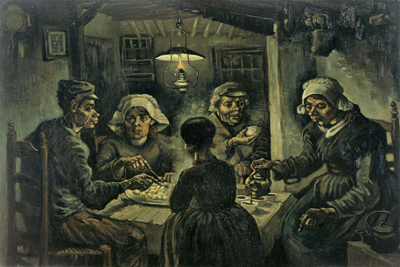
Considered to be the first significant artwork and the earliest masterpiece of Vincent Van Gogh, The Potato Eaters, completed in 1885, is the culmination of the artist’s months of study of the working class families, their traditions and habits. He created hundreds of sketches on the subject, until he settled on the scene depicted in the painting. Although he was from a fairly affluent background, Van Gogh had a fascination with the working class and his interest in the working class has often been compared to his fascination with the Tahitian communities.
After moving to Nuenen in the Netherlands in 1883, he made up his mind to create a portrait of the working class and wrote to his brother Theo that he wants to present the idea of a wholly different way of life. He worked on the painting from April 13 until the beginning of May, depicting a group of peasants, perhaps a family as they really were, deeply rooted in reality.

The Potato Eaters by Vincent Van Gogh is painted in a dark palette and echoing the dreary living conditions seen within the walls of the drab cabin, dimly lit only by a single lantern hung above the family table which some critics view as a symbol of family unity. Although the painting is dominated by dark and gloomy colours, the facial expressions of the peasants shine out brightly, revealing their expressions, which are serious and solemn. It seems from the faces and bodies of the men and women that they are not very happy, each of them is lonely and isolated and there is no response, no relieving communication between them. However, the expression of the young woman gazing at her husband seems to be a gaze of adoration and devotion, exhibiting a visible bond between the couple, which evidences that they have a life beyond the fields where they work.

However, the grouping of the figures at the sides of the table seems to be rather odd; as the wall between the two figures at the right creates a strange and almost forced partition of the intimate space. But within the gloom of the dark tonality, the eyes of two figures at the left shine, as if with an inner light and the shadows on their features are more a modelling of character than a phenomenon of darkness. Also shines in the gloomy darkness the pot and the cups of coffee, with their grey shadows, the potatoes on the platter and the heads of the men and women around the table. The colours of the dark interior, tinted with shades of blue, green and brown, seem to take us back to nature outside.

While trying to create his dream project, a true portrait of the working class, Van Gogh intended to create his first masterpiece that could boost his reputation as an upcoming artist and decided to paint down-to-earth human figures, who are gross, brutish, coarse and ugly, but not awkward and rather existing naturally. As he wanted to portray his Brabant peasants, he used the de Groots, a Netherlands farming family of his acquaintance, as the subjects of his painting and painted 20 or more studies of the family. His work involved a sincere attempt to portray domestic peasants at their normal, but pure and most primitive, as representing the ancient, traditional values of rural life. Prior to his final artwork, Vincent had three surviving studies of The Potato Eaters and also made lithographs of the image, which are held in collections including the Museum of Modern Art in New York City.
In 1989, an early version of the Potato Eaters was stolen from the Kroller-Muller Museum, while the final version was part of a group of 20 artworks stolen from The Vincent Van Gogh Museum in 1991. However, both versions were subsequently recovered.
